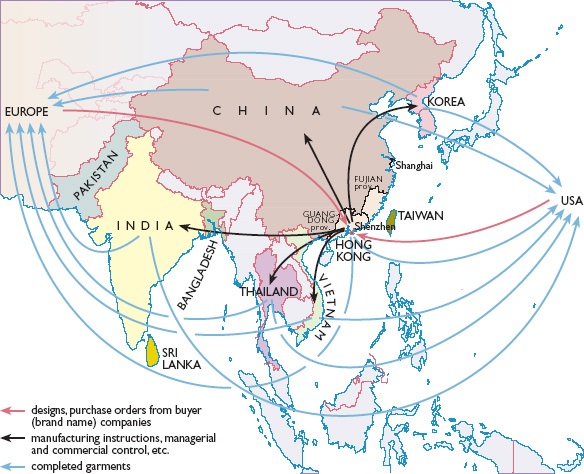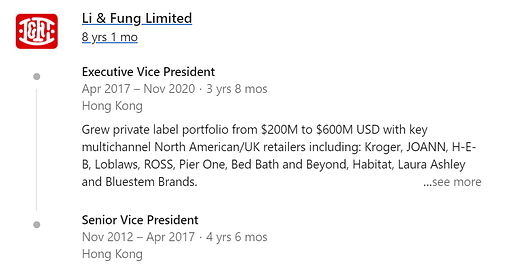I thought it would be nice to tell a story today. To understand the competitive landscape, management vision and business strategy, we start with the story of Li & Fung.
Two brothers, with an education spanning Princeton, MIT and Harvard Business School, turned their family run business into the world’s biggest supply chain company. They connected firms to a large network of factories, and weren’t simply middlemen, but broke large orders into pieces and sourced them from different factories in their network.

This ingenuous system revolutionized retail outsourcing in the 1990s. L&F could guarantee deliveries of massive orders in weeks, where previously it would have taken months. Likewise, factories throughout L&Fs network began to recognize huge increases in profitability through the uptick in utilization. Importantly further, L&F’s system broke up each order into a unique supply chain for that specific experience that was cobbled together for this one order, nearly erasing the ability for a customer to go direct to their suppliers and cut out the intermediary.
Factories became so reliant on this network, that L&F offered incredibly exploitative terms to these factories, which had a carry over effect of horrible working environments and negligible pay.
In the 2000s, L&F went through a string of acquisitions, buying more than 50 companies for over $6 billion in those days. These included shipping companies, huge retail brands, jewelry companies, furniture, you name it. The stock did incredibly well at this time.
In the next decade, this empire slowly hit disaster after disaster. Rising costs of labour in China forced L&F to look for cheaper manufacturing in Indonesia and Bangladesh. However they didn’t have the expertise in these regions and could not replicate their earlier revolutionary success.
Three large scandals hit their supply chain:
-
A fire (2012 Dhaka garment factory fire - Wikipedia) broke out, trapping workers and killing over a hundred people, injuring over 200 more. This was at a factory servicing L&F, and had been flagged as a high risk working environment.
-
The Rana Plaza collapse - where a building collapse in a garment factory killed over a thousand workers
-
Increased media coverage and protests lead to many retailers cancelling contracts with L&F. Here’s an excellent read on Li & Fung: https://www.nytimes.com/2013/08/08/world/linking-factories-to-the-malls-middleman-pushes-low-costs.html
A culmination of these factors lead to the downfall of L&F, and from its peak in 2010, it lost > 95% of its stock value:
With this information in mind, let’s revisit some of the management’s comments:
They’ve set up two state of the art factories in Bangladesh. They’ve made sure the workers are comfortable by having special glass panelling put in, which reduces ambient temperature. They’re using high automation and new technology. They’ve invested in solar plants and these factories do not produce any waste, as it’s converted into electricity.
We also know they have their network factories audited every three months, and every single investment they’ve made has been revolutionary in terms of sustainable clothing, from dealing with returns and take backs, new generation cotton, new generation recycled fabrics, etc.
I had a conversation with a friend who’s worked in a sourcing company. The key learning for me was that sourcing companies are misunderstood. Intuition tells us that they offer services, are middlemen, and therefore have no moat. The truth is that being able to deal with customs, different cultures across borders, form relationships with factory owners in community driven environments, deliver goods on time reliably are incredibly understated, and forms a moat that few can replicate at scale. Li & Fung’s story tells us exactly this; a global sourcing empire failed to conquer Bangladesh. If they were simply middlemen, they wouldn’t have failed.
PDS has set itself up to be Li & Fung’s anti-thesis. Management speaks about these disasters and codes they follow in Bangladesh. Until recently, most of their growth was organic and mostly debt free. They’ve taken L&F’s biggest weaknesses and have turned it into a core strength - sustainability across the supply chain. They’ve found success in sourcing from markets such as Bangladesh and Cambodia. The closing line from the conversation was that we’re fortunate that one of Li & Fung’s contenders is listed in India.
As a closing remark, PDS has hired two senior officials to spearhead expansion into the US markets. One of them, Eric Leddel, has the following background:
@kalpesh4430 I hope this goes someways in answering your first two questions. They’re incredibly relevant, and I’ll write about the two plants in Bangladesh and the rest of the management shortly.


